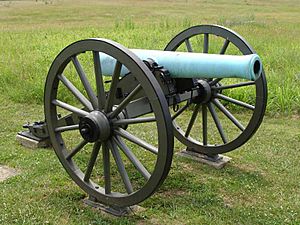Model 1857 12-Pounder Napoleon Field Gun facts for kids

The Model 1857 12-Pounder Napoleon Field Gun was a very important cannon. The United States Army called it the "light 12-pounder gun." It was the most popular smoothbore cannon used during the American Civil War. This powerful gun got its name from Napoléon III, who was the president and later emperor of France. He was also the nephew of the famous Napoleon Bonaparte.
History of the Napoleon Cannon
The original cannon was developed in France in 1853. It was called the Canon obusier de campagne de 12 cm, modèle 1853. People also knew it as the Canon de l’Empereur, which means "Emperor's Cannon." This cannon was special because it could fire different types of ammunition. It could shoot cannonballs, shells, and even canister shot or grapeshot. This meant it could replace many older French cannons.
The French cannon was made of bronze and had a smooth barrel. It could work as both a regular gun and a howitzer. A howitzer is a type of cannon that fires shells in a high arc. The Napoleon was light enough for horses to pull it. Yet, it was strong enough to damage enemy forts from about half a mile away (805 meters). When Emperor Napoléon III started using it, the cannon was named after him.
The Napoleon in the American Civil War
In 1857, the United States Army decided to use this design. They called it the light 12-pounder M1857. During the American Civil War, the Union army made 1,156 of these cannons. The Confederacy made 501. The South did not have as many factories as the North. So, Confederate soldiers tried to capture as many Union-made Napoleon cannons as they could.
The Confederate army also made their own versions of the Napoleon. In 1863, General Robert E. Lee was very impressed by the M1857. He ordered all the six-pounder cannons in his army to be sent to Richmond, Virginia. There, they were melted down and remade into 12-pounder Napoleons. Confederates kept making these cannons until the Union army captured the Ducktown copper mines. This made it harder for the Confederates to get bronze. After that, Confederate 1857s were made from iron instead of bronze.
Features of the U.S. M1857 Napoleon
When the first Model 1857 cannons were made in Northern factories, they had two handles. These handles were called "dolphins." After 1861, these handles were removed. The barrel was also made shorter than the French version and became lighter. Like most cannons back then, the Napoleon was a muzzleloading weapon. This means soldiers loaded the ammunition from the front of the barrel.
The Model 1857 12-pounder Napoleon was very common. Cannons with its bronze barrel made up 40% of all cannons used by both sides in the war. The U.S. version of the Napoleon could hit a target up to 1,700 yards away. However, it was most accurate at closer distances, around 250 yards.
It used about 2.5 pounds of black powder to fire. The M1857 Napoleon could shoot a cannonball or canister shot at 1,440 feet per second (about 439 meters per second). The barrel was 4.62 inches wide inside and 62 inches long. The barrel alone weighed 1,220 pounds. With its gun carriage, the whole cannon weighed 2,445 pounds. A team of six horses was needed to pull it. An average gun crew had six men to operate it.

